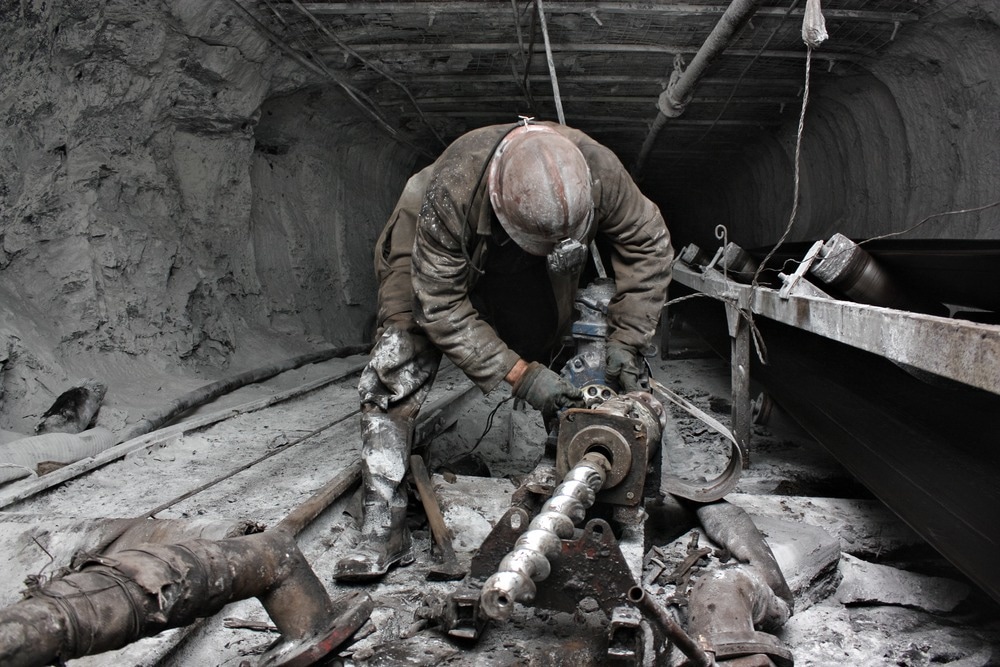Mines are notorious for their innately complex and constantly changing working conditions. Underground deep shaft mines contain a variety of explosive, toxic, and hazardous gases, which can harm the miners' health and are liable for various natural hazards such as fires and explosions within the mines.

Image Credit: Vyacheslav Svetlichnyy/Shutterstock.com
Developing intelligent systems that integrate Internet of Things (IoT)-enabled sensors, artificial intelligence and wireless networks for real-time prediction and monitoring of underground deep shaft mine hazards has become critical to resolving these problems.
The Dangers of Coal Mining
A large percentage of coal extracted worldwide is deep underground, necessitating the application of underground mining techniques. As a result, workers must access and operate within extremely confined spaces.
Dust inhalation is among the main dangers for miners within these deep confined spaces. Inhalation of coal dust particles can lead to a variety of health-related issues for those exposed. For example, continuous intake of coal dust can result in a disease referred to as that "miner's black lung".
Another significant issue for mine workers is the risks associated with methane (CH4) gas. Methane is notorious for its highly explosive nature, instantly igniting when exposed to a spark or flame.
It is pertinent to know that there are also dangers due to negligence. Unfortunately, safety precautions are not always followed, which could be due to ignorance, lack of awareness, or even intentional violations.
Role of Sensor-Based Systems in Mining Hazard Mitigation
There are many techniques that companies and organizations are employing to mitigate the dangers associated with coal mining.
Companies are implementing IoT-enabled sensor dust control systems to safeguard workers from dust pollution. These systems include sensors for real-time supervision, database APIs, and analysis platforms.
Data on dust concentration within the mine is monitored in real-time and is shared with an analytical engine which provides unique insights on the dust level in targeted locations to service engineers. Engineers and supervisors can then make educated judgments on minimizing dust levels to make mining conditions safer.
To alleviate the hazardous effects of methane, gas detection, airflow circulation, and ventilation monitoring devices have been created by technology suppliers. These sensors detect the presence of poisonous and combustible gases in the environment. Alerts are given to workers if there is a gas leakage or an explosion. Airflow sensors also guarantee that appropriate ventilation within the mine.
The use of IoT and artificial intelligence in the mining industry has also enhanced the personal health management of workers.
Tiredness and fatigue-related accidents, heat and humidity-based stress, and other health hazards pose a continual threat to miners. As a result, organizations are providing a variety of smart gadgets to monitor mine workers underground as a mitigation strategy. These measures are helping save lives and significantly decrease workplace injuries within mines.

Image Credit: Mark Agnor/Shutterstock.com
Sensor-Based Safety Systems for The Mining Industry in Action
Edinburgh Sensors, a sensor-based system manufacturer that specializes in sensors for mining operations, has been offering gas monitor technology for many years.
Gascard NG, an infrared-based gas detector designed and produced by Edinburgh Sensors, is an example of a sensor-based system used within mines for worker safety. Gascard NG, developed for simplicity of integration, is a suitable OEM sensing device for detecting methane in Mines. It detects and measures various gases and has increased functionality, future expandability, and configurable choices.
The system provides real-time mine condition monitoring through onboard sensors allowing for automatic temperature and pressure modifications. The system relays accurate concentration readings and reliable measurement of target gases within mines while also being simple to integrate with already installed Instruments and systems.
Innovations in Sensors-Based Systems for Mining Applications
Advancements in sensor-based systems are ever-increasing. Recent breakthroughs have combined IoT, artificial intelligence and sensor-based technologies for applications in mining operations.
Dust Master System (DMS) is an IoT-enabled system that monitors and controls dust levels throughout the mining operation. This system continuously monitors and manages the dust suppression process.
AI-based systems such as "Smart hats" that detect worker weariness are also in use within the industry. These hats have an array of sensors within the cap that analyze brain waves and recognize patterns that indicate fatigue. The caps then relay the information to engineers and safety supervisors, who are then alerted.
Sensor-based health monitoring helmets are another recent invention. These helmets monitor vital characteristics of the worker, such as pulse, position, body temperature, and work conditions. The data from the helmet is transmitted to a safety control center for monitoring, analysis, and rapid action.
Smartwatches, smart gadgets, and environment-based sensors are being used to track and safeguard worker well-being through IoT-enabled platforms. The collected information is processed and evaluated in real time. The system then transmits critical safety information to engineers and supervisors. If a danger occurs, the platform notifies engineers and supervisors accordingly.
References and Further Reading
Sathishkumar, N. et al. (2021). Safety Monitoring System in Coal Mine Using IoT. Journal of Physics: Conference Series. doi.org/10.1088/1742-6596/1916/1/012196
Duarte, J. et al. (2022). Sensing Technology Applications in the Mining Industry—A Systematic Review. International Journal of Environment Research and Public Health. doi.org/10.3390/ijerph19042334
Edinburgh Sensors (2022). Methane Sensing for Coal Mining Applications. Edinburgh Sensors. Available at: https://edinburghsensors.com/methane-sensing-for-coal-mining/
Solovyova, V. (2022). Improving Safety with AI and IoT for the Mining Industry. Softeq. Available at: https://www.softeq.com/blog/ai-and-iot-in-mining-for-safety-real-life-examples
Disclaimer: The views expressed here are those of the author expressed in their private capacity and do not necessarily represent the views of AZoM.com Limited T/A AZoNetwork the owner and operator of this website. This disclaimer forms part of the Terms and conditions of use of this website.